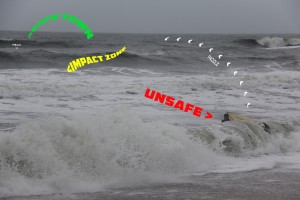Today as I was doing the Mid Day Surf Report, I noticed someone “giving a lesson” in the shore pound. Not only was it an illegitimate surfing lesson, but the rider and the instructor were both getting smashed into the sand multiple times, sometimes right on top of each other and the board. This is not what you would call practicing good ocean safety, so I decided to take the time and explain a couple of things to keep you and your children safe out there in the water.
CHECK CONDITIONS:
Check the local surf conditions before you decide to go to the beach, just because it says the waves are huge doesn’t necessarily mean that they are worth surfing. When its choppy and disorganized there are normally a lot of rip currents. Beginners want to stay AWAY from big waves, there is nothing there for you other than a massive thrashing, possible drowning, and possibly hitting/getting hit by someone else out there in the water. Lessons are always safest in knee-waist high, clean, and sunny conditions when you can easily paddle to the outside with ease.
SHORE POUND:
If you check out the picture above you can see two people getting slammed onto the shore. This is the best example of shore pound/shore break you can get. Although shore break can look surf-able, it normally closes out straight onto the sand. This poses a threat when the surf is over 3ft because you can literally get slammed on your head, board, or worse. The example surfers were sitting in the Impact Zone (see picture) trying to catch a wave that closes out on shore.
IMPACT ZONE:
The impact zone is the area where the waves break over the sandbar. It’s the most turbulent area in the water. Your time in the impact zone should be as little as possible, constantly paddling towards the outside. Your goal when surfing is to paddle out past the impact zone to “Safe Town” or the Safe Zone. Getting caught in the impact zone is dangerous because surfers can hit you and you can also get thrashed by incoming sets.
SAFE TOWN:
This is commonly known as the “outside” or the “lineup”. The outside is the most tranquil of the areas because you are sitting in deeper water where the waves do not break. The lineup refers to where all of the riders sit to catch a wave. When you’re sitting on the outside you are looking for the “peak” of the wave to paddle into. This is the most powerful part of the wave and prime spot to get enough speed to stand up and go down the line. Click here for more information on “Managing a Lineup” (general info and rules).
MARINE LIFE:
Dangerous marine life exists in the ocean; you are in their home now. It is important to be comfortable with your swimming and water environment. Predatory animals are known to bite people that are flailing about in the water like a dying fish. Sharks sometime mistake surfer’s feet when chasing a school of fish and bite down. Pay attention to what’s going out in the water. Look for movement, schools of jumping fish, or a smelly fish. If you see something, DON’T PANIC! Being calm is the number one safety skill in the ocean.
I didn’t hit every single safety point out there… I could write it all day…but these are some basics. Surfing lessons are highly suggested not only for safety, but to learn the proper techniques. Never go into any activity with no knowledge
If you have any questions or would like to know more please give us a call @ (904) 471-1122
Love,
Wes









